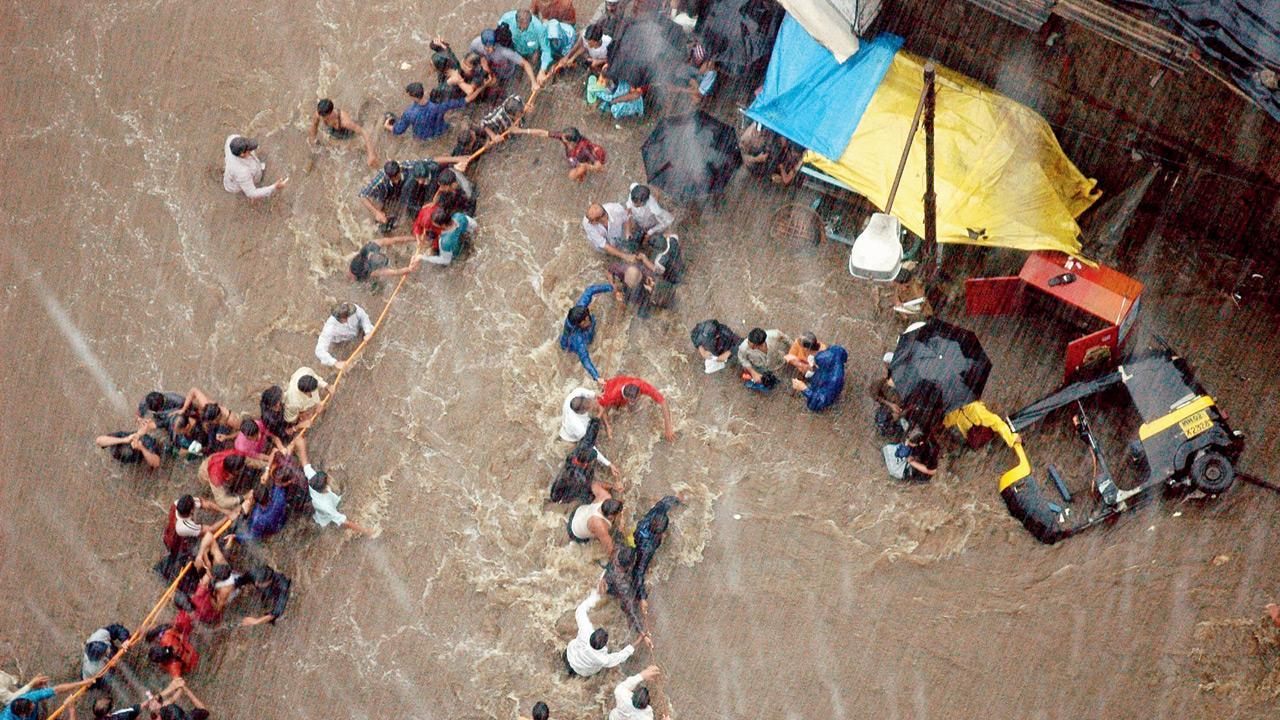The findings of the IPCC report, which stated that 12 Indian cities might be submerged by the end of the century, is within the ‘realm of possibility’, says one of its contributing authors

Mumbai saw one of the worst rainfalls in the city on July 26, 2005. In this file photo, citizens are seen partially submerged in the floods near Andheri East. Pic/Ashish Rane
On August 9, the Intergovernmental Panel on Climate Change (IPCC)—the United Nations (UN) body for assessing the science related to climate change—released its 6th Assessment Report.
ADVERTISEMENT
Making alarming conclusions, it provides new estimates of the chances of crossing the global warming level of 1.5 degrees Celsius in the coming decades. The report finds that unless there are immediate, rapid and large-scale reductions in greenhouse gas emissions, limiting warming close to 1.5 to 2 degrees Celsius will be beyond reach.
Based on the IPCC’s report, scientists working at the US-based space agency NASA have analysed changes in sea levels across the globe by creating a sea-level projection tool that makes data on future sea level rise accessible to the public. Shockingly, NASA has identified 12 coastal cities in India—including Mumbai—that are likely to find themselves submerged under three feet of water by the turn of this century.
Other Indian cities located along the coast that could bear the similar brunt of climate change are Kochi, Vishakhapatnam and Chennai. The report states that coastal areas across the globe will see a continued rise in sea levels throughout the 21st century, thus, contributing to frequent and severe flooding in low-lying areas, accompanied by coastal erosion. This indicates that extreme sea level events—which previously occurred approximately once every 100 years—could now take place almost on a yearly basis by the end of this century.
Mumbai witnessed heavy rains last month as well. In this photo taken on July 21, 2021, waterlogging can be seen at Kurla-Bandra Freeway Road. Pic/Sameer Markande
Speaking with mid-day, Krishna Achuta Rao, who is one of the contributing authors in the IPCC report, said, “One of the key findings is that the Indian Ocean is warming at a faster rate than the rest of the globe. Waters are warming much faster within our neighbourhood.” He also added, “Another implication is that as the waters get warmer, it [water] creates conditions for enabling tropical cyclones.
Essentially, this means that more fuel becomes available for these tropical cyclones to form [in terms of the heat of the water], which leads to the formation of stronger tropical cyclones. Now, when you have a combination of higher sea levels and stronger cyclones, it is going to end up affecting coastlines and coastal cities much more. Coastal erosion is going to become a problem; infrastructure and human lives along the coast as well as offshore, like what we saw during the recent Maharashtra floods, will be in danger.”
He further pointed out that coastal areas would end up receiving more intense rainfall. “Tropical cyclones will be dumping more rain and even without that, coastal areas will have more rainfall—especially along the west of India, where there is heavy rainfall every year during monsoon. This is because as the climate becomes warmer, the air ends up holding more water, and when these water-laden winds come and hit the Western Ghats, they end up with a heavier rainfall spell.”
Speaking about the possibility of 12 Indian cities being submerged under water, Rao said that “this is within the realm of possibility”. Certain cities, he says, could experience a higher rise since water levels don’t increase uniformly. “If there is wind in a certain direction, then there is water that tends to pile up in that direction and these factors start affecting the sea level. You can also have local variations in the water temperature as well as local changes in its salinity that could influence how high the water level is.”
However, Rao says that the chances of Mumbai and the other 11 Indian cities located along the coast being submerged under water by 2100 is not as much a “prediction” as it is a “scenario” modelled on what happens at different levels of CO2. “Being submerged a metre under water is a ‘high-emission’ scenario, which we are likely to end up at if we don’t do anything to control our emission and burning of fossil fuels,” he said.
When asked if we could do anything to reverse, or even limit this change in expected sea level rise across the world, he said, “We need to stop emitting and burning fossil fuels. This cannot happen overnight, which is why we need to ramp it down and quickly get the levels as close to zero as possible. By doing so, this scenario of Mumbai and other Indian coastal cities finding themselves submerged under water by the end of the century, will be will be pushed to say 300 years from now.”
He concluded, “We are already feeling the effects of climate change throughout the world in the form of extreme weather events. It is there for us to see in the headlines on almost a daily basis. This is
only going to get worse as we emit more and more greenhouse gases.”
 Subscribe today by clicking the link and stay updated with the latest news!" Click here!
Subscribe today by clicking the link and stay updated with the latest news!" Click here!






